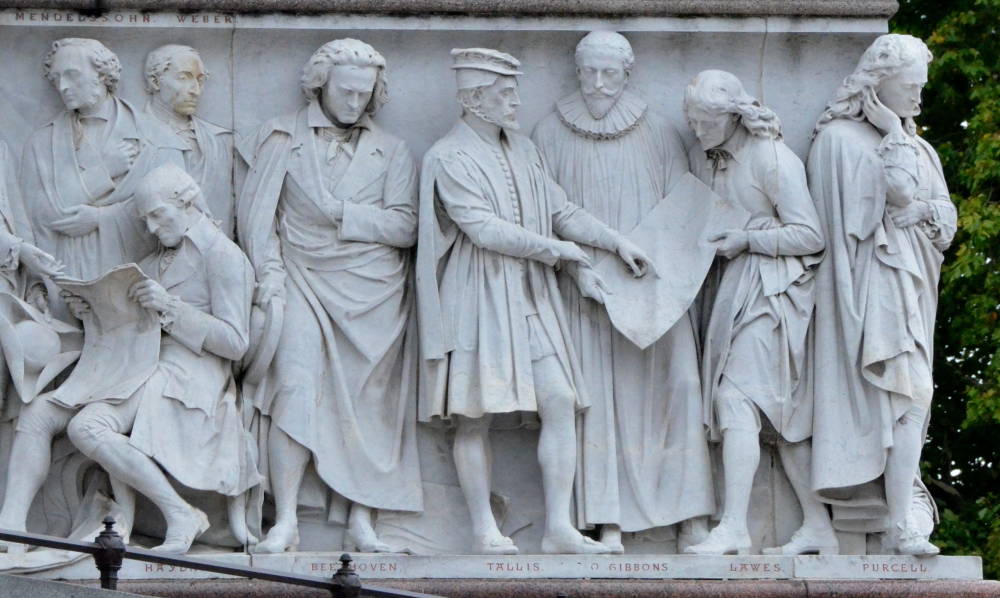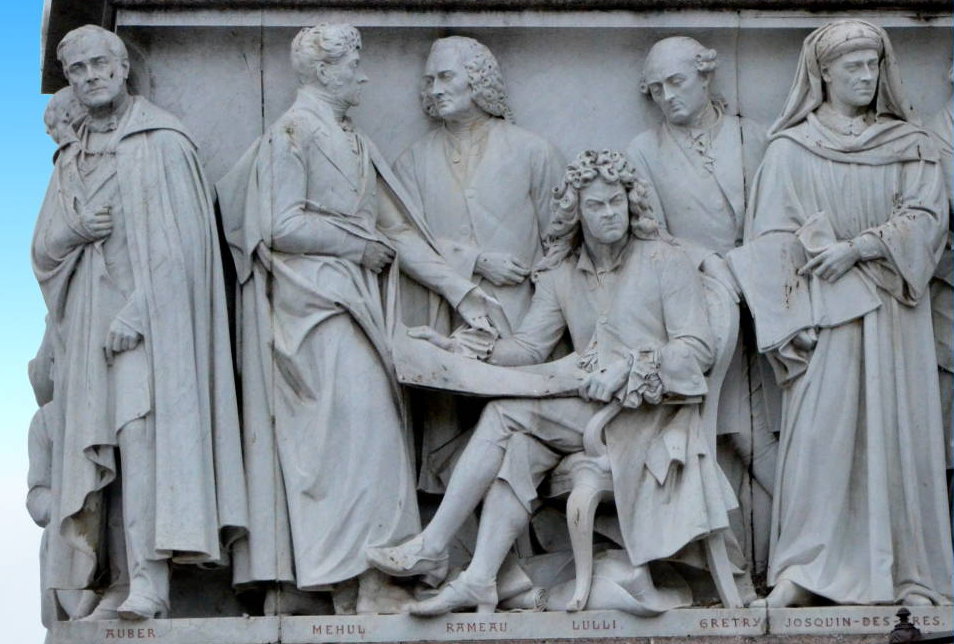
The frieze, which appears beneath Thomas Thornycroft's Commerce group, depicts great figures in the history of music, here great French and Italian composers — left to right: (a) Daniel-François-Esprit Auber (1781-1871), (b) Étienne Méhul (1763-1817), (c) Jean-Philippe Rameau (1683-1764), (d) Jean-Baptiste Lully (1632-1687), (d) André Grétry (1741-1813), Josquin des Prez (c. 1450–1521), Claudio Giovanni Antonio Monteverdi (1567-1643), Giacomo Carissimi (1605-1674), and Giovanni Pierluigi da Palestrina (1525-1594) (Wikipedia).
Commentary by John Lucas Tupper (1872)
The musicians are now ranged right and left. Next to Schiller (on our right) stands Bach, debating with Handel some point which seems to interest Gluck, who leans over to listen. Mozart, who follows, has submitted his score to Haydn, seated and intently perusing it. Mendelssohn, inclining forwards in abstraction, seems in the group, but not of it. Weber, in a weird reverie, stands next him; while, with one unconscious hand grasping Haydn's chair-back, the other slung listlessly in his breast, the wholly solitary Beethoven lets his profound head hang over in forlorn absorption.

Then follows a spirited group of three English composers, with Gibbons in the centre, Lawes on our right, and Tallis on our left. What is in the scroil we do not know, for the sculptor will not condescend to the trick of writing on it; but it is grasped by Gibbons and held open by Lawes, while Tallis places an admonishing finger on it, and at the same time lays a gentle expostulating pressure on the hand of Gibbons that holds it. There is a living look in this action -- which is wholly inexpressible. Purcell stands at the angle in isolated thought, listening to "ditties of no tone." He does not, however, quite end the group of English composers, since Arne, Boyce, and Bishop (the last two in low relief), extend half way upon the salient face of this wing, shared” by them with some English painters.

The opposite wing has Auber at its inner salient angle. His right hand in a fold of his French cloak, and his head a little stooping and leant sideways, he stands wholly free from that taint of self-consciousness which poisons so much modern work.Then we meet a discoursing group of four, of which Méhul standing, and Grétry sitting with a scroll on his knee, are the front figures; and Rameau (talking to Méhul) and Grétry (leaning on Lulli's chair) the back ones. Méhul is alluding to thc scroli. Josquin Deprez flanks the French group. He is in ecclesiastical garb, which, together with his look of sly humour, forcibly reminds us of his motet, -- Portio mea non est in terra viventium — to quicken Louis' memory of the promised benefice. These points of costume, which Mr. Armstead has scrupulously observed throughout the world are of incalculable interest and value in point of art.

Next to Josquin Deprez, Rossini stands, his hand playing at the skin of his throat; and, next to him, Monteverde, with his finger at Palestrina's shoulder, starts fairly into the group he forms part of, his heel and shoulder to the spectator. Palestrina, reared back, with his hands placed deliberately over each other and rested on the knob of Guido d'Arezzo's chair, has a steadfast, calm dignity. Carissimi shows his face, and little more, very effectively between Monteverde and Palestrina. But perhaps the rnost absolutely living figure is Guido d'Arezzo, the inventor of musical notation, as he sits poring over his page, his knee rocking sidewise, and whispering, you will swear, the notes' names for his soul's satisfaction. St. Ambrose, with a volume in his hand, fills the gap above.
Bibliography
Tupper, J. L. “Henry Hugh Armstead,” English Artists of the Present Day. Essays” by J. Beavington Atkinson, Sidney Colvin, F. G. Stephens, Tom Taylor, and John L. Tupper. London: Seeley, Jackson, and Halliday, 1872, 61-66.
Pevsner, Nikolaus. Berkshire. London: Penguin, 1988.
Content last modified 12 November 2011
Reformatted 16 March 2015